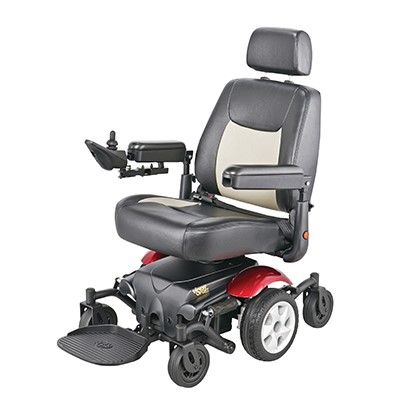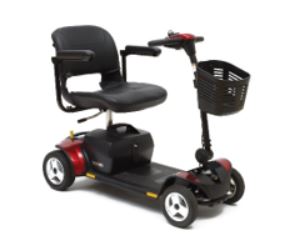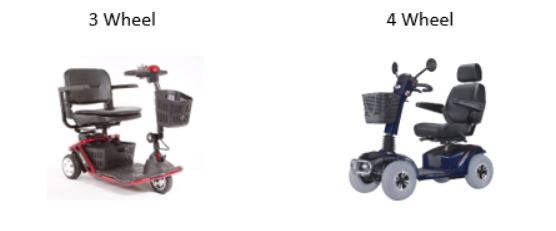Posted by Scott Dannenberg - President on Aug 16th 2016
Cheat Sheet
Power Chair vs. Scooter
People use these terms interchangeably but they are actually very different devices. Here’s a comparison of features to help you pick out which would be the best to assist you where you need it the most.
Ask yourself 4 questions to decide what really works best for you.
1. Where do I need to use it the most?
2. How can I transport it?
3. How long will I use it daily?
4. Is it appropriate for my height and weight?
Power Chair

A. Tight turning radius for inside the home maneuvering. They can “turn on a dime”, pull up directly to a table for eating or a desk, without having to transfer to a regular chair. Can also pull up right next to the bed for easy transfers. Great for outside too!
B. Heaviest Piece starts around 90 pounds on most units. Best to get a platform to attach to your vehicle to be able to take it with you.
C. The seat is usually a high back Captains seat design with semi-reclining back and contoured padding. Standard seat sizes are usually 18"-20" deep and 18"-20" wide. Other sizes are available on certain models.
D. Wheel configurations: Power Chairs have 3 types of designs: Front Wheel Drive, Center Wheel Drive, and Rear Wheel Drive. Front Wheel typically is more sensitive to steer and has a slightly larger turning radius. The center wheel is the most natural feeling to maneuver and truly turns on a dime. Rear wheel is easy to steer and has good traction if used outdoors.
E. Power Chairs are divided into the following categories:
- Portable: Relatively light weight and come apart without tools.
- Standard: These fit most people up to 285 lbs. Very sturdy and lots of choices.
- Heavy Duty: These are the most rugged designs for heavy people over 285 lbs or for heavy use. They have larger seats, bigger batteries, motors, and suspension.
F. Controls: A Powerchair has a joystick control at the end of the armrest. The on/off button, horn, speed control, and steering toggle (which also controls breaking) are right where your hand naturally rests while you sit.

Scooter

A. Larger Turning Radius: Good for open areas like stores, outdoors, traveling, or shopping. also helpful in retirement communities where the dining area is too far away to safely walk.
B. Heaviest Piece starts at 29-35 pounds for most units. Easy to take apart and store in a truck or back seat.
C. The seat is normally a stadium design which is shown above. It is surprisingly more comfortable than it appears. Standard seat sizes are usually 16"-18" deep and 16"-18" wide. Other sizes are available on certain models.
D. Scooters come in either 3 or 4 wheel configurations. 3-Wheel Scooters offer a slightly smaller turning radius but is less stable ourdoors or on uneven surfaces. 4-Wheel Scooters are more stable for outdoor use or "off-road" travels.
E. Scooters are divided into the following categories:
- Folding: These scooters do not require any assembly. They fold open to ride, then fold closed to be stored. Some models auto-fold with the push of a button on a remote key fob.
- Lightweight/Portable: These are designed to easily disassemble or set up and have lightweight, easy to connect pieces.
- Midsized Scooters: These are designed for heavy use throughout the day and have nice upgrades. Will not be as lightweight as the portables.
- Heavy Duty/Luxury: These are designed for people who either want the most luxurious ride, longest ranges on one charge, and all the upgrades, or people who need a weight capacity up to 500 lbs. These will not be light weight.
F. Controls: A scooter has a front tiller steering column with instrument panel that is angle adjustable. This allows the rider to have the controls at a comfortable reaching distance.

Below we have some “hybrid models" that offer the benefits of the inside maneuverability of a power chair, with the portability of a scooter.

 Loading... Please wait...
Loading... Please wait...


